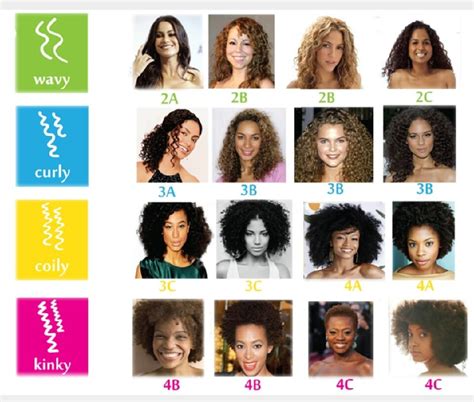Introduction
With over 65% of the world’s population having curly hair, it’s time to celebrate this diverse and beautiful spectrum. Curly hair is characterized by its unique spiral or coil shape, resulting in a wide range of textures, volumes, and patterns. Understanding the different types of curly hair can empower individuals to embrace their uniqueness, enhance their hair care routine, and find hairstyles that accentuate their natural beauty.

Understanding the Curl Classification System
The most widely accepted curl classification system is the Andre Walker Hair Typing System. This system divides curly hair into four main categories, further subdivided into three subcategories based on curl tightness, strand thickness, and overall volume.
| Category | Subcategory | Code | Curl Description |
|---|---|---|---|
| Type 2 | 2A | Loosely Wavy | Soft, S-shaped waves that are easily straightened |
| Type 2 | 2B | Wavy | Defined S- or C-shaped waves that may have some frizz |
| Type 2 | 2C | Curly | Well-defined curls that form tight ringlets without being too coarse |
| Type 3 | 3A | Loosely Curly | Large, bouncy curls that are flexible and defined |
| Type 3 | 3B | Curly | Defined curls that are tighter than 3A, with a circumference of a dime or smaller |
| Type 3 | 3C | Tightly Curly | Coiled curls that are corkscrew-shaped and have a circumference of a straw |
| Type 4 | 4A | Coily | Fine, tightly packed coils that form zigzags |
| Type 4 | 4B | Coily | Z-shaped coils that are wiry and have less definition |
| Type 4 | 4C | Coily | Extremely tightly packed coils that are fragile and prone to breakage |
Embracing Your Curl Type
Each type of curly hair possesses its unique charm and requires specific care to maintain its health and beauty. Here are some tips for embracing your specific curl type:
Type 2 Curls:
* Use volumizing shampoos and conditioners to enhance wave definition.
* Avoid over-brushing, as it can lead to frizz.
* Experiment with different styling creams and gels to define waves.
Type 3 Curls:
* Condition regularly to maintain moisture and elasticity.
* Use styling products designed for curly hair to minimize frizz and enhance curl definition.
* Protective styling techniques, such as braiding and twisting, can preserve curls.
Type 4 Curls:
* Moisturize daily with oils, creams, or leave-in conditioners to prevent dryness.
* Use a detangling brush or wide-toothed comb to minimize breakage.
* Protective hairstyles, such as bantu knots and locs, can reduce friction and damage.
Troubleshooting Common Curly Hair Challenges
Frizz: Frizz is caused by a lack of moisture and can be exacerbated by environmental factors. Use anti-frizz products, deep condition regularly, and avoid over-brushing to combat frizz.
Dryness: Curly hair is prone to dryness due to its tight coils, which limit the distribution of natural oils. Use sulfate-free shampoos, condition deeply, and apply leave-in conditioners to keep curls hydrated.
Breakage: Curly hair is more fragile than straight hair and can be prone to breakage. Use gentle handling techniques, avoid over-manipulation, and incorporate protective hairstyles to reduce breakage.
Beyond Hair Care: Celebrating the Beauty of Curly Hair
The beauty of curly hair extends far beyond its physical appearance. Curly hair represents diversity, empowerment, and self-expression. It has become a symbol of strength, resilience, and cultural heritage.
Empowerment: Curly hair has historically been associated with marginalized communities. Embracing curly hair represents a rejection of societal norms and a celebration of one’s unique identity.
Diversity: Curly hair is a testament to the vast array of human diversity. It encompasses a wide range of textures, patterns, and colors, reflecting the beauty of our planet.
Self-Expression: Curly hair allows individuals to express their creativity and individuality. It can be styled in countless ways, offering endless possibilities for self-expression.
Conclusion
The world of curly hair is a vast and beautiful tapestry, filled with endless variations and nuances. By understanding their curl type and adopting appropriate care techniques, individuals can unlock the full potential of their curly tresses. Beyond its physical attributes, curly hair holds significant cultural and social meaning, empowering individuals to celebrate their uniqueness and embrace their true beauty.
